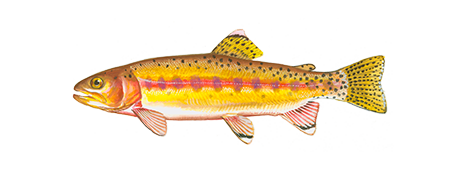Golden Trout

The golden trout is considered to be a highly desirable and almost mystical species.
HOW TO IDENTIFY A GOLDEN TROUT
Due to its coloration and markings it is considered one of the most beautiful of all freshwater game fishes. It is the only species of Salmonidae in which the parr marks on the sides typically remain prominent throughout life rather than disappearing at an early age. A red streak similar to that of a rainbow trout runs along the sides through the ten or so parr marks. The tail is golden yellow (as is most of the body) and is covered with large black spots that radiate outward toward the edge as in the rainbow, cutthroat, and some other closely related species. Usually the posterior part of the body is heavily spotted. The forward part of the body may have spots above the lateral line on the back and top of the head, but not always. The upper fins are golden yellow and heavily spotted. The lower fins are orangish or reddish with no spots. The dorsal fin and the ventral and anal fins have white tips (in some specimens) that are often separated from the rest of the fin by a broad black line. The sides of the head and throat are a blend of rosy red and golden yellow. When this species is brought down from its high altitude habitat and propagated at low altitudes, it loses its brilliant colors and becomes steely blue.
WHERE TO CATCH GOLDEN TROUT
The golden trout is native only to the upper Kern River basin in Tulare and Kern Counties, California. This trout occurs in clear, cool waters at elevations higher than 6,890 ft. Despite its limited distribution, there are two recognized sub-species of golden trout: Oncorhynchus aguabonita aguabonita, which is confined to the south fork of the Kern River and Golden Trout Creek, and Oncorhynchus aguabonita gilberti, which is confined to the Main Kern and Little Kern Rivers. An area of warm water where the South Fork joins the Kern apparently serves as a natural barrier that keeps the two subspecies apart. Golden trout have been introduced to other areas, including the states of Washington, Idaho, and Wyoming, which have self-sustaining populations. It is believed that most of these populations have hybridized with the cutthroat trout. According to some fisheries scientists, most trout in the Kern River basin are also hybrids of recent origin and the only pure populations of golden trout are those limited to the headwater areas. The following list includes additional details on where to catch this fish:
BACKFLOW HOLES
OPEN WATER RIVERS AND STREAMS
DAMS AND FALLS EDDIES
SMALL POINTED WAVES UNDERCUTS
FRESHWATER LAKES AND PONDS INLETS AND OUTLETS
OUTSIDES OF BENDS ROCK AND BOULDER POCKETS
DROP-OFFS MERGING CURRENTS
STANDING WAVES CURRENT EDGES
HOW TO CATCH GOLDEN TROUT
Fly fishermen and other anglers have to match their lures to the types of food items available at the high altitudes where the golden trout occurs. Caddis flies and midges are most effective, though many golden trout have been caught with spoons, spinners, worms, salmon eggs, small crustaceans, and various small insects. The following are fishing methods used to catch this fish:
JIGGING FLY FISHING BAIT CASTING
SPIN CASTING DRIFT FISHING TROLLING
STILL FISHING
GOLDEN TROUT LURES, TACKLE & BAIT
The following are lures, tackle or bait that can be used to catch this fish:
CURED FISH ROE JIGS SPINNER BAITS
FLIES SALTWATER LIVE BAIT SPOONS